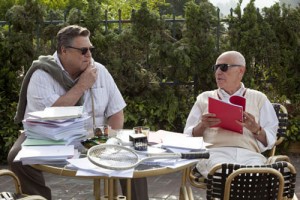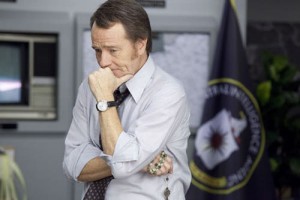Interview: Bryan Cranston and John Goodman of “Argo”
Posted on October 17, 2012 at 8:00 am
 In Argo, Bryan Cranston (“Breaking Bad”) plays the CIA chief who supervises Tony Mendez, the character played by director Ben Affleck. And John Goodman plays real-life Oscar winner John Chambers, the genius in make-up and prosthetics who secretly worked with the CIA on disguises. Mendez called Chambers for help in setting up the fake Hollywood studio they needed to create cover identities to get the six Americans hiding out in Iran back home. A small group of journalists met with Affleck, Goodman, and Cranston to talk about the film.
In Argo, Bryan Cranston (“Breaking Bad”) plays the CIA chief who supervises Tony Mendez, the character played by director Ben Affleck. And John Goodman plays real-life Oscar winner John Chambers, the genius in make-up and prosthetics who secretly worked with the CIA on disguises. Mendez called Chambers for help in setting up the fake Hollywood studio they needed to create cover identities to get the six Americans hiding out in Iran back home. A small group of journalists met with Affleck, Goodman, and Cranston to talk about the film.
What is the challenge in playing a character based on a real person, knowing that people who knew him will see the film and people who didn’t know him will think that they know what he was like based on your performance?
John Goodman: First and foremost, I had a responsibility to the character I was playing because he actually existed. He was a well-respected makeup artist, so I just felt the  responsibility to not step on my foot.
responsibility to not step on my foot.
Brian Cranston: My character was a composite character, and I think it was carefully crafted that way because at the time that you keep cutting back to the CIA and finding out more information and what’s happening back there, it was important to not have the audience confused for a second. If there was numerous people that were at the CIA giving him instruction and guidance, if the audience is going, “Which guy is it? Was that the guy from the White House or is that the guy…” then, we’re in trouble, because then they’re not listening. So, we didn’t want to slow it down and so my character became the composite character. But you know, it’s interesting. Some people will say, “Well, actors, they’re liars, right? They get up and pretend and say they’re someone else,” and the truth is that we desperately seek the truth and the honesty of a character, and we don’t feel completely comfortable until we find out how to play someone with that integrity. But yes, I think Ben and John had slightly more sense of responsibility because they’re portraying real people.
What do you think was going on inside the minds of these men as they went through these extraordinary challenges?
Bryan Cranston: Well, I had the good fortune of coming to Langley, Virginia early on before we started shooting and I sat down with a few CIA officers of varying degrees of experience. I wanted to get sort of a baseline of who these people are, and get a sense of the culture that they live in, and I guess what I came away with is that it’s not dissimilar from any other corporate structure. They’re still complaining about the boss and his crappy idea, and “that’s not going to work,” and there’s stale coffee in the break room and there’s all these kinds of things that they have to deal with. I think at first they were a little reticent to open up to a stranger. At first they would say, “There are several things we can’t talk about, you know, mission wise.” And I go, “I’m actually more interested in what your personal life is like and what sacrifices that were made with your spouses, what were you able to tell your children? How did it affect you? Your relationships? Do you guys drink? Did you go to a certain place to associate with other officers?” And there’s very much a club, in fact, one of the things that I found interesting was that a lot of them will socialize within and marry within, so that one guy was married to a CIA officer and their daughter was a CIA officer, and so it’s the family business. What I thought, going in, was “This is going to be completely different from anything that I have ever known” but it became sort of familiar to me. I just wanted to craft this man being a dedicated servant, truly believing in the value of the CIA and what he’s providing for it. I had a sense that, if this worked, this would be Jack’s last mission, that I’m going, “it’s not going to be any better than this, so I’m going to get debriefed and walk away.”
John Goodman: It’s like the idea of a man who manufactures disguises, disguising a part of his life and hiding in plain sight and serving his countries with the tools of his trade.


